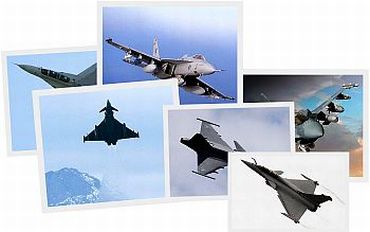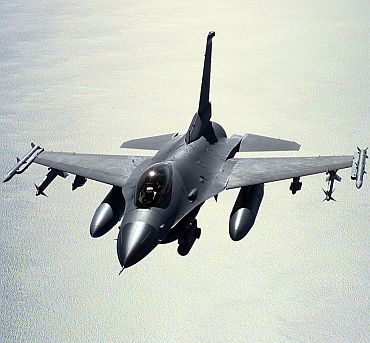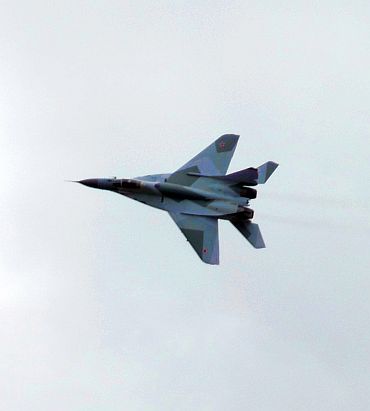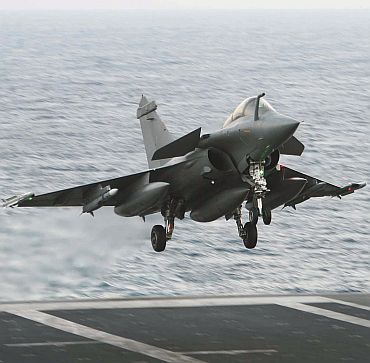Ajai Shukla in New Delhi
The elimination of four aircraft vendors from the $9.5 billion global competition to sell 126 medium multi-role combat aircraft to the Indian Air Force has not been accepted quietly.
Business Standard has learned that the ministry of defence (MoD) has already received letters from all four inquiring why their fighters were found unfit.
The first inquiry was from Russia, asking why the IAF had found the MiG-35 unsuitable.
Next was the US Embassy in New Delhi, asking for the specific reasons that had led to the elimination of the two American fighters, the Boeing F/A-18 Super Hornet; and the Lockheed Martin F-16IN Super Viper.
...
Loophole: A MoD procedural error
MoD sources also confirm that Sweden's Gripen International has written in, seeking details of why the fancied Gripen NG fighter was ruled out.
Earlier, on 27th April, the MoD had written to the four vendors briefly outlining, but not detailing, the reasons for their elimination. The remaining two vendors --- Eurofighter GmbH; and Dassault of France --- were asked to extend the validity of their price bids, given two years earlier.
Vendor protests after elimination from a tender would usually be rejected as a pro forma exercise. This time, however, a MoD procedural error could provide vendors with a lever to claw their way back into contention.
The MoD's Technical Oversight Committee (TOC), which must review the IAF's technical evaluation and flight trials to ascertain that procurement procedures were followed in full, had not completed its work before the MoD sent out the rejection letters.
'Politically influential vendors' may re-enter bid
Image: American F-16Now, the three-man TOC -- headed by the Scientific Advisor to the Defence Minister, VK Saraswat, and with Bharat Electronics Limited chief, Ashwini Datt and the IAF's Air Marshall Anil Chopra as members -- is scrambling to complete this mandatory review.
Aviation experts apprehend that this procedural lacuna could be exploited by one of the "politically influential vendors" (read Boeing and Lockheed Martin) to re-enter contention.
Senior IAF officers, however, emphatically rule out selecting either American fighter.
Says an IAF officer involved in the selection process: "The US companies, which flaunt their technological leadership, are feigning hurt that their fighters were found technologically unsuitable. But it was their misjudgement to offer the IAF fighters like the F-16 and the F-18 that are decades old. It is arrogance to claim that these have been modernised and are good enough for a country like India. But if they wanted to argue technology, they should have fielded the F-35."
Why the Russians are angry
The Russian vendor, RAC MiG, is also upset with the IAF's rejection but for another reason.
"The MiG-35 has been developed in Russia as a natural replacement for the 2000-odd MiG-21s that are in coming to the end of their service lives in tens of air forces around the world. With the IAF -- a bastion of MiG fighters -- rejecting the MiG-35, the Russian builder worries about the negative signal that this will send across the world," points out Pushpindar Singh, aerospace expert and editor-in-chief of the trade magazine, Vayu.
Meanwhile, Gripen International is fine-tuning its strategy for appealing the IAF's rejection.
According to the MoD's letter to the company, the Gripen NG was found non-compliant with the IAF's tender requirements on 51 counts, of which 43 relate to the critical Active Electronically Scanned Array (AESA) radar.
Why Gripen is grumbling
Gripen International argues that it is unfair to say that the IAF has not been provided "proof of technology", or proof that the Gripen NG's Selex AESA radar (which is still under development) has surmounted the key technological obstacles needed for operationalising it in time for delivery to India.
That is because Selex (in partnership with Euroradar) is also developing the Eurofighter's AESA radar, which the IAF has accepted as technologically viable, and likely to be ready in time for delivery to India.
Gripen points out that if Selex has convinced the IAF about having mastered the technology for the Eurofighter's AESA radar, that same technology will drive the Gripen NG's radar.
But IAF sources reveal that Gripen failed to provide proof that their AESA radar development was on track and that they could integrate that radar on a fighter.
The gloves are off
In contrast, Dassault had fitted two prototype AESA radars on Rafale fighters, proving that they were close to completion.
Eurofighter too test-flew a prototype AESA radar for the IAF evaluation team, convincing them that it would be ready by 2014-15.
So far, all six vendors had conspicuously praised the MMRCA technical and flight evaluation procedures, declaring that this was the most professionally handled competitive procurement that they had ever encountered anywhere.
Now, clearly, the gloves are off.








article